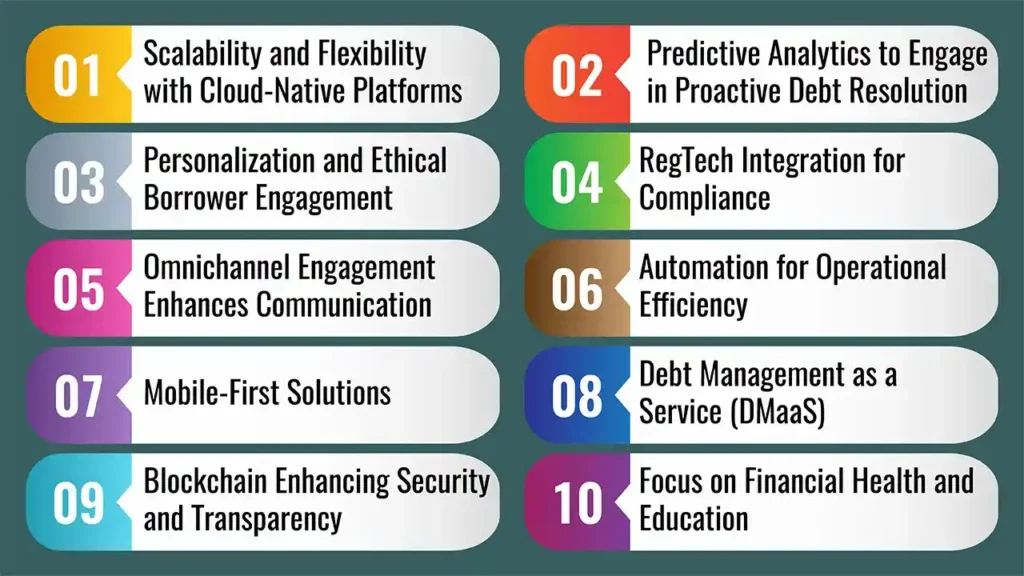In 2025, debt management technology is transforming quickly to serve the needs of 21st-century borrowers and lenders. The days of manual work and collections being on the attack are over. Technology today allows for a more empathetic, streamlined, and compliant approach to debt portfolio management, with customer experience taking centre stage.
The top trends shaping debt management technology in 2025 demonstrate a scenario where cloud computing, data analytics, automation and ethical borrower engagement intersect to reimagine the way in which debt is managed.
This article describes these trends neatly and easily, making it clear to the reader what it means in terms of change in the way that financial institutions around the world are practising.
Here are the 10 Top Trends Shaping Debt Management Technology in 2025

1. Scalability and Flexibility with Cloud-Native Platforms
Cloud-native platforms are one of the biggest changes in the technology of debt management and the relational shift they encompass. Such cloud-based systems give lenders access to instantaneous portfolio management, which results in better coordination between branch offices, call centres and digital teams. 5) Cloud is elastic. Cloud platforms are scalable; they can scale easily according to increased or seasonal workloads without massive capital outlay on hardware.
These include near real-time data sharing, the ability to integrate new features such as mobile pay gates, as well as external data source integration. This agility means that from changing regulations to borrower preferences, lenders are able to keep pace and maintain the most advanced offering on the market with cloud-native technology at its core.
2. Predictive Analytics to Engage in Proactive Debt Resolution
Through the power of predictive analytics, debt management technology is evolving out of reactive collections and toward proactive engagement. Just by looking at payment history, transaction patterns, and sociodemographic data, lenders are able to predict which borrowers will fall behind on payments.
This data enables lenders to step in early with individually tailored plans that can stop loan defaults. The predictive models also maximise resource allocation through focusing attention on high-risk accounts, enhancing collection effectiveness and enhancing customer service at the same time.
3. Personalization and Ethical Borrower Engagement
Contemporary debt management tech acknowledges that borrowers are people with their own stories. Sophisticated platforms tailor the communication and repayment methods based on the borrower information and a culture of ethical, transparent networking.
Customisation also encompasses changing payment dates to coincide with when money is earned or spent and communication to any borrowers based on their preference — whether that is SMS, phone, email or mobile apps. Ethical debt collection is not only in line with industry regulation; it intuitively inspires borrower confidence in few collection compliance and possible repayment behaviours.
4. RegTech Integration for Compliance
Making it complex, as data privacy laws like GDPR and industry regulations evolve fast. Debt management software today even includes RegTech—regulatory technology—tools that automate monitoring and reporting compliance.
These are all platforms that allow you to track your borrower communications in real time, manage consents automatically, and have audit trails that decrease overall risk. Proactive compliance not only shields institutions from fines but also aligns with ethical collection, which borrowers and regulators approve of.
5. Omnichannel Engagement Enhances Communication
Communication forms the backbone of debt management. Today’s debt technology platforms offer omnichannel engagement, enabling borrowers to communicate in their preferred manner—text, voice calls, emails, chatbots or social media.
This methodology ensures that no matter how the message goes out, the message itself is consistently relayed and there are fewer chances for missed contacts or errors. Omnichannel technology also allows for seamless jumping between channels within a conversation, increasing transparency and borrower experience.
6. Automation for Operational Efficiency
Automation such as RPA (robotic process automation) is increasingly embedded in debt management technology to process repetitive work. Payment processing, statement generation, reminder notifications, and data key entry are all automated, allowing human agents to concentrate on complicated and sensitive borrowers.
Automation saves mistakes, reduces operating costs and enables us to respond quicker to borrower enquiries, raising the overall level of service and the efficiency of the debt recovery profession as a whole.
7. Mobile-First Solutions
Today’s borrowers want to be able to manage their debt on the go. In mobile-first, in-depth technology solutions arm borrowers with apps and portals to see balance, make payments, negotiate and receive personalised reminders.
Borrowers can engage more readily on mobile by offering the convenience and access borrowers should expect today, as well as support tools. In-app financial literacy educational content also serves borrowers by empowering them to manage their debt and preventing future delinquencies.
8. Debt Management as a Service (DMaaS)
A growing trend is that of Debt Management as a Service (DMaaS), where subscribers deploy incremental, cloud-based DM solutions without having to bear the costs or complexity of developing or operating their own systems.
DMaaS solutions come with pre-built integrations to analytics, legal, and so on, with a dashboard as a single point to enter, and an organisation saves money by going to multiple assets/software and implementing them. This model provides affordable access to advanced debt management technology even to smaller lenders and non-banking financial companies.
9. Blockchain Enhancing Security and Transparency
Secure, permanent ledgers and smart contracts made possible by blockchain technology are starting to affect debt management tech devices. Payments and contracts are documented in a transparent way, which can help prevent fraud and disputes.
Smart contracts automatically enforce the repayment conditions while also guaranteeing the rules of the contract are fairly applied every time. Blockchain can demonstrate better trust and auditability over debt management processes, even though it is at an early stage of adoption.
10. Focus on Financial Health and Education
The function of DMT is evolving from collections to facilitating consumer financial wellness. Lenders offer customised budgeting features, spending insights, and educational content to help borrowers better understand and improve their financial wellbeing.
By educating about good financial planning and providing real help, lenders can drive future defaults down while creating more solid borrower relationships in the long term.
Final Words
The Top Trends Shaping Debt Management Technology in 2025 showcase a transition from hard-coded, automated collections to more informed, compassionate systems. Advancements such as cloud-hosted solutions, predictive analytics and integration capabilities with RegTech are enabling the management of debt to become more efficient, compliant and borrower-centric.
Omnichannel and mobile-first solutions provide greater flexibility in communication, while automation and DMaaS contribute to cost reduction and the acceleration of innovation. New tools like blockchain and financial wellness support add to the transformation.
Frequently Asked Questions
1. What is debt management technology?
Debt management technology refers to the software and systems used by lenders or collectors to manage debt portfolios, track payments, communicate with borrowers, and comply with regulations.
2. How does predictive analytics help in debt management?
Predictive analytics makes predictions about borrower behaviour using data, enabling lenders to intervene early, tailor repayment plans and maximise collections—and minimise defaults.
3. Why Is Custom Communication an Essential Part of Debt Management?
Personalised communication addresses each borrower as a person and customises messages and repayment plans accordingly, and this helps to establish trust, improving the likelihood that the borrower will be able to repay successfully.
4. How does cloud-native technology help with the debt’s lending?
Scalability, real-time data, collaboration and seamless integration enable debt management to be faster and more adaptive to change within cloud-native environments.
5. How is regulations compliance being dealt with in the new debt management systems?
RegTech tool integration enables automated monitoring, consent management and reporting to maintain ongoing compliance with changing data privacy and collection regulations.

Leave a Reply